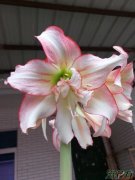How to raise Zhu Dinghong in autumn
It seems a bit late to write this article now. Flower friends can keep it for next year. This year, I can catch a little autumn tail. For how to raise C. Dinghong in autumn, we need to understand its habits first. For C. Dinghong, Under natural circumstances, the above-ground parts will wither and dormant in winter, and sprout again in the spring next year.
In other words, autumn is the last growth period of Hippeastrum. After flowering, Hippeastrum consumes some nutrients, and these nutrients need to be recovered in autumn. Therefore, in addition to normal maintenance in autumn, we should also supplement some nutrients to Hippeastrum.Phosphorus and potassium fertilizers are used as the main fertilizer. Fertilizers do not need to be fertilized. Maintain sufficient sunlight and proper moisture. In short, it is sufficient to eat and drink.
When the weather gets cold, Hippeastrum will wither naturally. We must reduce watering at this time to assist in the winter. It is enough for the pot soil to have a little humidity throughout the winter. Too dry is not good, too wet is easy to rot.So just a little bit of water to keep the bulbs alive.
In addition, some flower lovers like to cut the leaves of Hippeastrum in the late autumn. This is actually not very good. The leaves of Hippeastrum are not withered, indicating that the environmental climate has not yet reached the conditions for withering. Cut the leaves early. If the ambient temperature is stillHigh, Hippeastrum will continue to grow leaves and consume nutrients. Not only does it fail to save nutrients, it also encourages it to consume more nutrients.
- Related knowledge
- What kind of fertilizer is applied to Hippeastrum to enlarge the ball deep burial + potash fertilizer
- Is it one-time use of Hippeastrum bulbs? No, it can breed bulbs every year
- Zhu Dinghong is suitable for shallow pots or deep pots, how deep is the appropriate depth, and several balls in a pot
- Do you want to cut the leaves after Hibiscus is blooming? Don't
- When does Zhu Dinghong cut the leaves
- How does Zhu Dinghong take root fast fast rooting method
- Can Hippeastrum bloom without dormancy | Without cutting the leaves
- Will Zhu Dinghong be dug out in winter? Not used in most cases
- When will Zhu Dinghong change pots?
- The difference between purple root orchid and Zhu Dinghong picture
- Editor's recommendation
- The breeding method of hyacinth picture and text teach by hand
- The breeding method of hyacinth
- How to deal with lily after blooming
- Causes of yellowing of cyclamen leaves
- Comparison of hyacinth and grape hyacinth
- Introduction of lily varieties
- Post-flower management of Zhu Dinghong
- The cultivation method of gladiolus gladiolus
- Problems and misunderstandings of hyacinth clip arrows
- Control the five elements of fragrant snow orchid freesia


